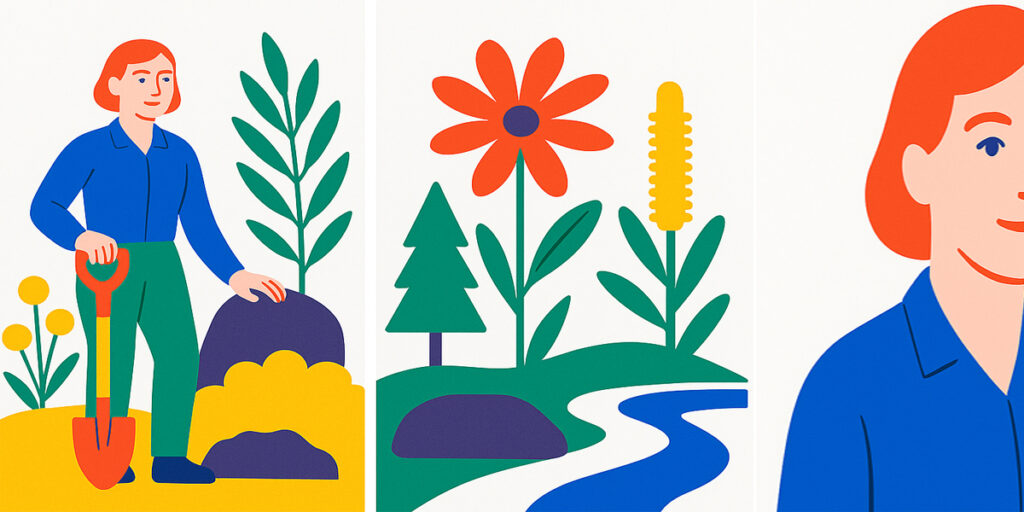Beneath the blazing skies of a wide brown land, where eucalyptus leaves glitter in the heat and dry winds whisper through waving grasses, a woman moved with quiet purpose. Her name was May Rawson. She didn’t trace the lines drawn by others—she shaped her own journey through dust and shadow, stone and bloom. In her hands, she carried the outlines of a new kind of beauty. In her thoughts, the rhythm of the land pulsed like a steady drum. And within her spirit lived a deep harmony with the fierce, wild grace of the Australian earth.
May was born not into noise, but into nature. From her earliest days, she understood that a garden wasn’t just something you planted—it was something you listened to. She saw patterns in the soil, the language in the curve of a gum leaf, the wisdom in drought-resistant bark. While others clipped hedges into boxes, she stood beneath a paperbark tree and imagined a world where wildness was celebrated, not conquered.
As the world around her filled with imported lawns and English roses, she made a choice to turn toward what was already here. Wattle, grevillea, bottlebrush—names that grew from the land like stories passed through generations. She believed in plants that knew the rhythm of the land, that could dance with the sun, that asked for little but gave everything. Her gardens whispered strength. They bloomed not with spectacle, but with soul.
In the mid-20th century, when sustainability was not a word in common use, she was already dreaming it in color. She used stones collected from nearby creeks, not imported marble. She created water pathways that mimicked the natural slope of the land. She chose plants that could thrive without demanding more than the climate could give. In her world, nothing was wasted. Everything had a reason to exist, and that purpose found harmony.
She saw the Australian landscape not as a backdrop but as a teacher. She taught others to look closer—to see the silver underside of the eucalyptus leaf, the sculptural beauty of banksia cones, the grace of kangaroo paw flowers reaching upward like a salute to the sun. Her designs didn’t fight the elements. They flowed with them.
Every space she touched became a story in motion. A path lined with crushed granite wasn’t just a walkway—it was an invitation. A cluster of native grasses wasn’t filler—it was sculpture. Her gardens were open books, written in textures and tones. They asked people to slow down, to look deeper, to remember where they were.
But May was not just a designer of gardens—she was a shaper of minds. She mentored, guided, challenged. She shared her knowledge with those willing to listen, always urging them to find meaning in the plants of their own country. She believed in the strength of local identity, in the poetry of native flora, in the freedom that comes from working with, not against, nature.
She had a special way with contrast—pairing rugged stone with soft flowers, balancing harsh light with cooling shadows, echoing the dance between survival and beauty that defines the Australian bush. In every space she shaped, there was a sense of belonging. Nothing felt imposed. Everything felt grown.
May never needed a stage. Her legacy lies underfoot and overhead—in the gardens that still bloom with integrity, in the designers she quietly inspired, in the growing appreciation for native plants across the continent. She was not loud, but her work echoes louder with time. In every rustle of a grass tree, in every beesong over a blooming banksia, her spirit hums on.
Even now, decades later, her gardens are alive. They evolve. They adapt. They breathe. That is her truest achievement—not a single flower bed, but a way of thinking that continues to grow.
She taught that to honor land, you must first know it. You must feel the seasons with your fingertips, understand the silences between storms, listen to what the soil is saying. She believed that landscape architecture was not an art of control, but of collaboration. And through that belief, she transformed the way Australia saw its own ground.
The beauty of May Rawson’s work is not just what you see—it’s what you feel. The calm of shade in a sun-struck afternoon. The song of native birds echoing through a planted corridor. The coolness of stone after a night of rain. These are the gifts she left behind, more lasting than monuments.
She gave a nation back its voice through the plants that had always been speaking. She gave gardens their native tongue.
And today, in every thoughtful garden that rises from the soil with respect and resilience, her spirit grows again. Not in marble, not in iron, but in life—in roots, in bark, in bloom.




















